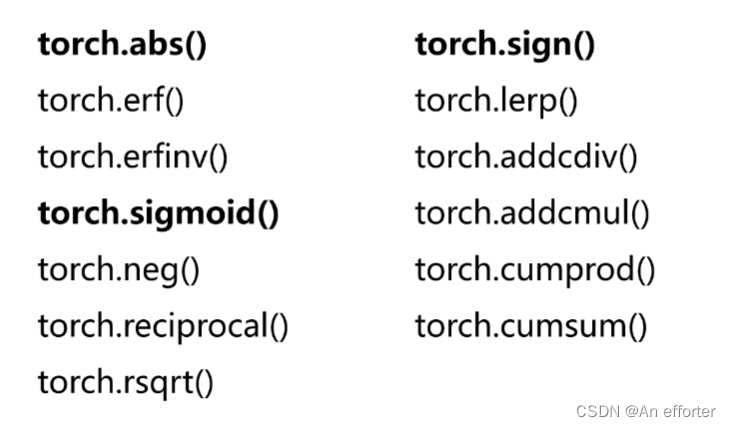目录
(1条消息) Pytorch框架的学习(2)_An efforter的博客-CSDN博客
(1条消息) Pytorch框架的学习(3)_An efforter的博客-CSDN博客
一、Pytorch的基本概念
pytorch的三大基本的概念:tensor(张量),Variable(变量),nn.Module(网络结构)
1、tensor(张量)概念

从上图中,我们一点一点的引入,标量是零维的张量,向量是一维的张量,矩阵是二维的张量。从上图右边中就可以看出来。
引入到真实操作中:

先解释样本与张量关系:
算法工程师经常提到一个名词:我的数据怎么怎么样,这个数据其实就是样本,tensor(张量)就是把样本的特征给描述出来。
再深入一点,怎么描述?
可以这么想,其实就是我们选择一张图片,彩色图片(RGB)含有三个通道,每一通道就是当成一矩阵,图片中含有特征的,那么在矩阵中就会对应第几行几列的数值。那么H*W*C(长*宽*通道)就是一个标量。
解释模型与张量关系:
模型包含两类:有参与无参模型。 对应着上图中Y=W*X+b函数来看,X就是样本,W与b在未知的情况下是变量。变量也是用tensor表示的。最后的到Y(标签)也是进行数字化的,所以和tensor也形成了直接联系。
2、tensor的用法
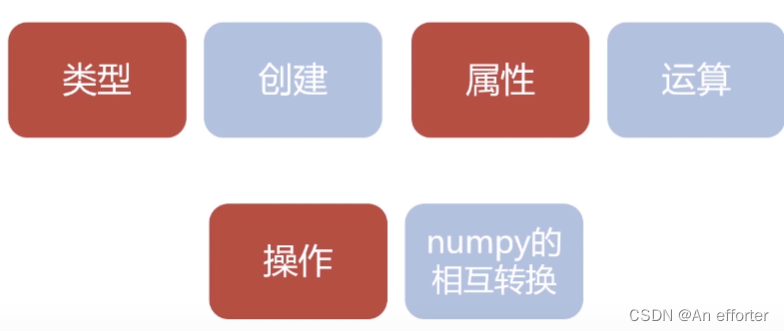
2.1、tensor的类型

tensor的类型,跟c语言中学习的差不多,无非加了在torch下的类型。
2.2、tensor的创建

结合代码操作:
import torch
a=torch.Tensor([[1,2],[3,4]])
print(a)
print(a.type())
b=torch.ones(2,2)
print(b)
print(b.type())
c=torch.Tensor(2,3)
c=torch.zeros_like(c) #把c的格式仿过来就变成两行三列都是0
d=torch.ones_like(c) #把c的格式仿过来就变成两行三列都是1
print(c)
print(d)
#随机
e=torch.rand(2,2)
print(e)
#随机打乱0-9
e=torch.randperm(10)
print(e)
#标准分布
f=torch.normal(mean=0.0,std=torch.rand(5)) #std是标准差
print(f)
#取范围
g= torch.Tensor( 2,2).uniform_( -1,1) #在-1,1之间
print(g)
#torch 中的序列
h= torch.arange (0,10,1)
print(h)
I= torch.linspace( 2,10,3)
print(I)对应的输出:
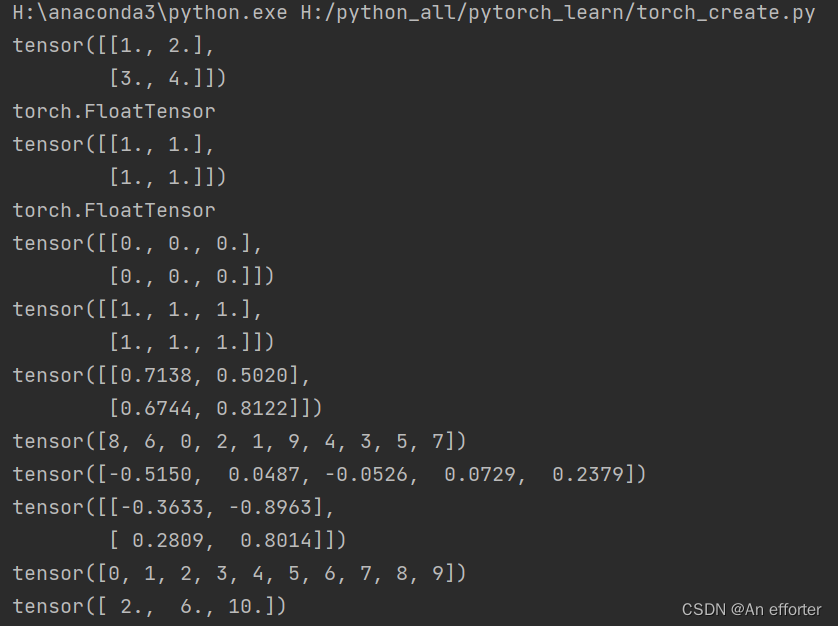
2.3、tensor的属性
- 每一个Tensor有torch.dtype、torch.device、torch.layout三种属性。
- torch.device标识了torch.Tensor对象在创建之后所存储在的设备名称。
- torch.layout表示torch.Tensor内存布局的对象。
实例:torch.tensor ( [1,2,3], dtype=torch.float32,device=torch.device('cpu') )
- torch.sparse_coo_tensor (稀疏矩阵)
- coo类型表示了非零元素的坐标形式
#稀疏的张量
import torch
dev=torch.device("cpu") #指定cpu
a=torch.tensor([2,2],
dtype=torch.float32, #tensor的三个参数
device = dev)
i= torch.tensor([[0,1,2],[0,1,2]])
v = torch.tensor([3,4,5],dtype =torch.float32)
x= torch.sparse_coo_tensor(i, v,[4,4],dtype=int,device="cuda").to_dense()
print(x)2.4、tensor的运算
以下图片代码都是一些使用方式:
(1).加法运算
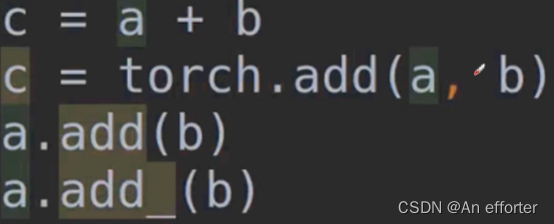
(2).减法运算
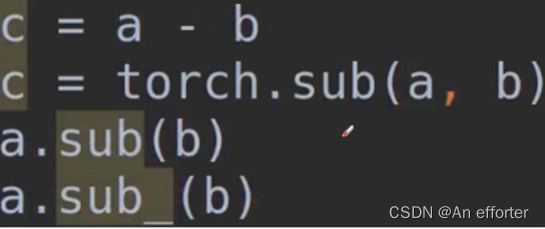
(3).乘法运算
- 哈达玛积(element wise,对应元素相乘)

(4).除法运算
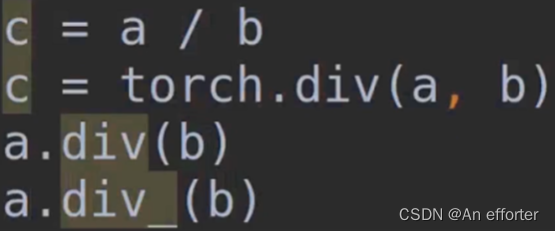
(5).矩阵运算
- 二维矩阵乘法运算操作包括torch.mm).torch.matmul()、@

- 对于高维的Tensor (dim>2),定义其矩阵乘法仅在最后的两个维度上,要求前面的维度必须保持一致,就像矩阵的索引一样并且运算操只有torch.matmul()。

(6).幂运算
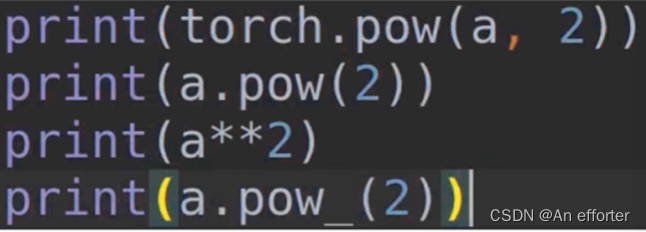
特殊的e^(a):

(7).开方运算

(8).对数运算 第三、四个方式底数是e

(9).tensor的取整/取余运算
- floor()向下取整数
- ceil()向上取整数
- round()四舍五入>=0.5向上取整,<0.5向下取整
- trunc()裁剪,只取整数部分
- frac()只取小数部分
- %取余
import torch
a=torch.rand(2,2)
a=a*10
print(a)
print(torch.floor(a))
print(torch.ceil(a))
print(torch.round(a))
print(torch.trunc(a))
print(torch.frac(a))
print(a%2)测试结果:

(10).tensor的比较运算
- torch.eq(input, other, out=None)#按成员进行等式操作,相同返回True
- torch.equal(tensor1, tensor2)#如果tensor1和tensor2有相同的size和elements,则为true
- torch.ge(input, other, out=None)# input>= other
- torch.gt(input, other, out=None)# input>other
- torch.le(input, other, out=None) # input= <other
- torch.It(input, other, out=None) # input<other
- torch.ne(input, other, out=None) # input != other 不等于
import torch
a=torch.rand(2,3)
b=torch.rand(2,3)
print(a)
print(b)
print(torch.eq(a,b))
print(torch.equal(a,b))
print(torch.ge(a,b))#大于等于
print(torch.gt(a,b))#大于
print(torch.lt(a,b))#小于
print(torch.ne(a,b))#不等于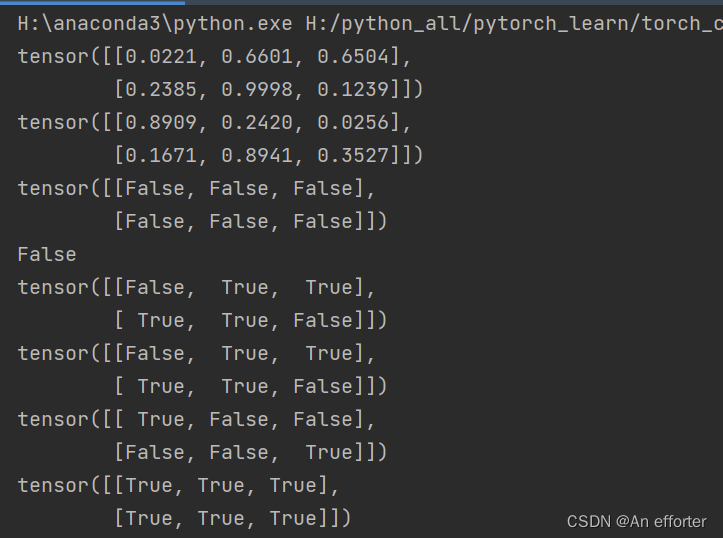
(11).Tensor的取前k大/前k小/第k小的数值及其索引
- torch.sort(input, dim=None, descending=False, out=None)#对目标input进行排序
- torch.topk(input, k, dim=None, largest=True, sorted=True,out=None)#沿着指定维度返回最大k个数值及其索引值
- torch.kthvalue(input, k, dim=None, out=None)#沿着指定维度返回第k个最小值及其索引值
c=torch.tensor([[1,2,3,4,2],
[2,3,4,12,3]])
print(c.shape)
print(torch.sort(c))
print(torch.sort(c,dim=1,descending=True))
#value就是值,indices就是索引值对应原来摆放的位置
##topk
d=torch.tensor([[12,3,1,2,4],[4,2,6,4,5]])
print(d.shape)
print(torch.topk(d,k=1,dim=0)) #在0维中组合成一个最大数组[12,3,3,4,5]
print(torch.topk(d,k=2,dim=1))#在一维中找到最大值两个【12,4】,【5,4】
print(torch.kthvalue(d,k=2,dim=1)) #在一维中找第二小的【2,4】
测试结果:

(12).Tensor判定是否为finite/inf/nan (有界/无界/张量中是否存在空值)
- torch.isfinite(tensor) / torch.isinf(tensor) / torch.isnan(tensor)
- 返回一个标记元素是否为finite/inf/nan的mask 张量。
-
##有界无界是否为空 a=torch.rand (2,3) print(a) print (torch.isfinite(a) ) print(torch.isfinite(a/0)) print (torch. isinf(a/0)) print(torch.isnan (a))测试结果:
-

(13).tensor的三角函数
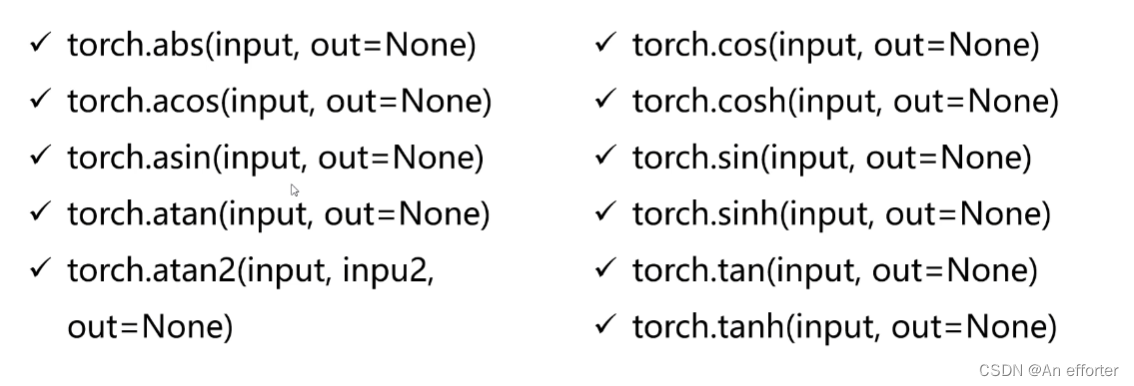
(14)tensor的其他的数学函数
